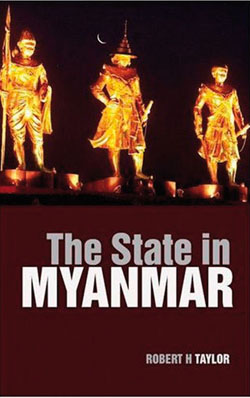
| By DAVID SCOTT MATHIESON | AUGUST, 2009 - VOLUME 17 NO.5 |
In the aftermath of the 1988 uprising in Burma, a new generation of military autocrats decided a makeover was in order. The rebranding of the Union of Burma into the Union of Myanmar in 1989 was as much to confuse memory in the wake of the mass killings of protestors by the army as it was to stamp a new look on the repression that had occurred since 1962.
One of the military government’s leading chroniclers is the academic Robert Taylor, whose landmark book “The State in Burma” was released in 1987 and gets its own rebranding in the updated “The State in Myanmar.”
 |
| The State in Myanmar,by Robert H. Taylor. National University of Singapore Press, 2009. P 540. |
Taylor has been widely maligned for his conclusions in the first book, whose final paragraph declares “for better or worse the state is accepted as inevitable” and that despite dissatisfaction amongst many Burmese with the ruling Burma Socialist Program Party, its disastrous economic management and reclusive foreign affairs, the system itself was in more or less sound shape.
This was repudiated not just by the popular uprising that rocked Burma several months after the book’s release, but by the architects of the socialist system itself. They included Burma’s strong man Ne Win, who admitted not just to the system’s unpopularity but also to its unsustainability under modern conditions. The socialist system was swept away and multi-party democratic elections promised.
The disagreements created by “The State in Burma” shouldn’t necessarily detract from its sweep of Burmese political history, at the time unprecedented since the work of the colonial scholar J S Furnivall.
Taylor applied some cutting edge theories of state structures to Burma at the time, and analyzed five “eras”—the pre-colonial state in the time of the Burmese kings at Pagan, Pegu and Ava; the “rationalization” of the state as the British took control between 1842 and 1852; another chapter on colonial administration; the “displacement of the state” under Japanese administration; and the short-lived democracy period from 1948 to 1962. He concluded with an analysis of the Burmese “way to socialism,” which he argued returned Burma to natural rule patterns.
Taylor’s summation of the state in Burma is almost an ode to autocratic expedience: “Burma had experienced capitalism and colonialism, depression, poverty, rebellion and anarchy during the lifetime of the generation that came to power after independence. Personal experience had convinced many Burmese that balance and authority were required to create social harmony.” In other words, people welcomed authoritarian rule.
Taylor was one of the first contemporary scholars to tackle this issue in his seminal 1982 monograph “An Underdeveloped State.” The study of Burma by Burmese and foreign scholars has advanced greatly since then, as evidenced by Andrew Selth’s recent survey , “Burma Studies: A View from the Edge,” and the seminal work of other scholars such as Tin Maung Than and Kyaw Ying Hlaing.
Yet the study of the “state” remains underdeveloped and undervalued, and much research on state structures in Burma is superficial, speculative and in many cases misinformed. This would summarize Taylor’s updated edition of his opus, where cosmetic rebranding hasn’t been able to gloss over the fundamental rot of the Burmese military system.
“The State in Myanmar” remains essentially the same as his earlier work, except for more than 100 pages tacked onto the end in a chapter called “The State Redux,” analyzing the period 1988-2007.
This is a meandering analysis of two decades in Burma’s development, politics, conflict, economy and social dynamics, and the author does little of it any justice. There are many minor factual errors throughout this section. Taylor is one of the most prominent scholars in the field of Burma studies, and unfortunately this updated edition does his career no justice.
The author’s preference for the military and his animus towards Aung San Suu Kyi and the opposition is laid bare in the new material. The most valuable addition to this edition is the updated bibliography, most of which is far more informative than the pop history, with its pages of meaningless tables, statistics and secondhand facts.
Taylor becomes a partisan provocateur with such formulations as “alleged human rights violations.” Any astute observer of the past two decades of Burmese military rule would conclude that widespread repression was a hallmark, not a hypothetical, feature of the state. Taylor barely acknowledges this fact, let alone analyses it, demonstrating his lack of interest in human security over regime security.
The author cautions us from the outset to avoid reading this book if it induces “apoplexy,” as if he is expecting or knowingly provoking a backlash. Still, I urge you: read on, critique, learn, debate and do better—perhaps that’s the best approach to Taylor’s work.
David Scott Mathieson is Burma Researcher in the Asia division of Human Rights Watch.